Page 518 - Deep Learning
P. 518
References 501
Press, G. A. (1977). History and the development of the idea of history in antiquity.
History and Theory, vol. 16, pp. 280–296.
Prigogine, I. (1997). The end of certainty: Time, chaos, and the new laws of nature.
New York: Free Press.
Pringle, J. W. S. (1951). On the parallel between learning and evolution. Behaviour, 1951,
vol. 3, pp. 174–215.
Proctor, R. W., & Dutta, A. (1995). Skill acquisition and human performance. Thousand
Oaks, CA: Sage.
Purves, D., & Lichtman, J. W. (1980). Elimination of synapses in the developing nervous
system. Science, vol. 210, pp. 153–157.
Putnam, H. (2005). A philosopher looks at quantum mechanics (again). British Journal
for the Philosophy of Science, vol. 56, pp. 615–634.
Pylyshyn, Z. W. (1973). The role of competence theories in cognitive psychology.
Journal of Psycholinguistic Research, vol. 2, pp. 21–50.
———. (1980). Computation and cognition: Issues in the foundations of cognitive
science. Behavioral and Brain Sciences, vol. 3, pp. 111–169.
———. (1986). Computation and cognition: Toward a foundation for cognitive science.
Cambridge, MA: MIT Press.
Quine, W. V. (1951). Two dogmas of empiricism. Philosophical Review, vol. 6,
pp. 20–43.
Quine, W. V., & Ullian, J. S. (1978). The web of belief (2nd ed.). New York: Random
House.
Radnitzky, G., & Bartley, W. W. III (Eds.). (1987). Evolutionary epistemology, rationality,
and the sociology of knowledge. La Salle, IL: Open Court.
Radvansky, G. A., & Dijkstra, K. (2007). Aging and situation model processing.
Psychonomic Bulletin & Review, vol. 14, pp. 1027–1042.
Raff, R. A. (1996). The shape of life: Genes, development, and the evolution of animal
form. Chicago, IL: University of Chicago Press.
Ramirez, V. E. (2002). Find the right problem. Asia Pacific Education Review, vol. 3,
pp. 18–23.
Ranney, M., & Schank, P. (1998). Toward an integration of the social and the
scientific: Observing, modeling, and promoting the explanatory coherence of
reasoning. In S. Read & L. Miller (Eds.), Connectionist models of social reasoning
and social behavior (pp. 245–274). Mahwah, NJ: Erlbaum.
Ranney, M., Schank, P., Mosmann, A., & Montoya, G. (1993). Dynamic explanatory
coherence with competing beliefs: Locally coherent reasoning and a proposed
treatment. In T.-W. Chan (Ed.), Proceedings of the International Conference on
Computers in Education: Applications of Intelligent Computer Technologies,
ICCE’93, Taipei City, Taiwan, December 15–17 (pp. 101–106).
Read, S. J., & Marcus-Newhall, A. (1993). Explanatory coherence in social
explanations: A parallel distributed processing account. Journal of Personality and
Social Psychology, vol. 65, pp. 429–447.
Reason, J. (1990). Human error. Cambridge, UK: Cambridge University Press.
Reber, A. S. (1996). Implicit learning and tacit knowledge: An essay on the cognitive
unconscious. New York: Oxford University Press.

